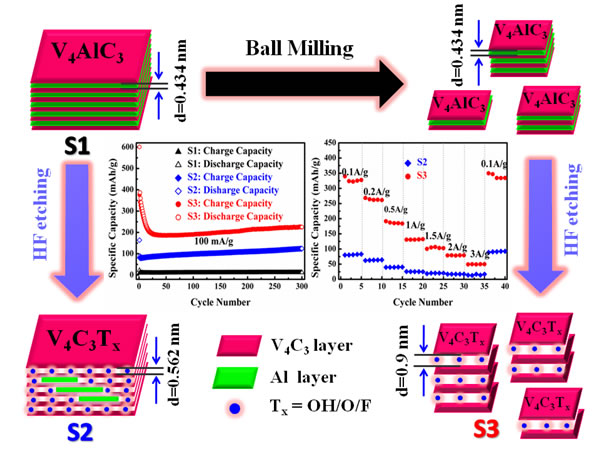Recently, researchers from the Functional Materials Laboratory of the Institute of Solid Physics, Hefei Academy of Material Sciences, Chinese Academy of Sciences have successfully prepared a new two-dimensional V4C3Tx MXene material and studied its application in lithium-ion batteries. Related research results are published in the Chemical Engineering Journal with the title of Synthesis and lithium ion storage performance of two-dimensional V4C3 MXene.
In electrochemical energy storage technology, lithium-ion batteries are widely used in people's lives due to their high energy density, long cycle life, environmental protection and no pollution, such as mobile electronic devices, electric vehicles, and grid energy storage. With the development of social economy, the current commercial lithium-ion batteries using graphite, lithium titanate, etc. as anode materials are more and more difficult to meet people's demand for battery capacity, and it is particularly important to develop new electrode materials. At present, the new two-dimensional MXene material has the characteristics of large specific surface area, good conductivity, and high ion diffusion rate. It has shown great application potential when used as a negative electrode material for lithium ion batteries, and has attracted wide attention from relevant researchers.
MXene is by selective etching of its precursor MAX phase compound (chemical formula is Mn + 1AXn, where M is a pre-transition metal element, such as Ti, V, Nb, Mo, etc .; A is a main group element; X is C Or N element; n = 1, 2, 3) A type of two-dimensional material made from the "A" element. Common MXene materials are Ti3C2Tx, Ti2CTx, V2CTx, Nb2CTx, Nb4C3Tx, etc. Tx represents the functional group on the surface of the material , Such as -OH, -O, -F, etc. In the more widely studied MXene materials, having a large interlayer distance and specific surface area are the key factors to obtain better lithium performance. Usually, people use an intercalator to strip multiple layers of MXene into fewer layers or even single layers to obtain large interlayer spacing and specific surface area. However, the stability of such small layers or even single layers of MXene obtained by the above method is poor, affecting the material Practical application. Studies have shown that with the increase of the value of n (n = 1, 2, 3) in Mn + 1XnTx, the stability of MXene has been significantly improved, so it is of great practical significance to explore and study the MXene material with M4X3Tx type.
In order to obtain MXene materials with large specific surface area, large interlayer spacing, and high stability, researchers at the Institute of Solid Materials chose MAX phase V4AlC3 as a precursor, using a combination of ball milling and hydrofluoric acid etching to obtain a size (400nm-50μm ) And a new two-dimensional V4C3Tx MXene material with controllable interlayer distance (0.434-0.9nm), and systematically studied the structure, morphology, stability and lithium battery performance of this type of material. The research results show that the multi-layer V4C3Tx MXene material with high stability was obtained by hydrofluoric acid selective etching, and the addition of the ball milling process made the above-mentioned multi-layer V4C3Tx fully fragmented, thereby significantly increasing its specific surface area and layer The spacing provides more active sites and faster transmission channels for lithium ion storage and transportation, which ultimately makes this type of two-dimensional material exhibit better lithium performance. After 300 charge and discharge cycles at a current density of 100 mA g-1, the specific capacity of the V4C3Tx MXene material is 225 mAh g-1, and it also exhibits good rate performance. This work provides an important reference value for the subsequent application of V-based MXene materials in the field of lithium / sodium ion batteries.
This research work was supported by the National Natural Science Foundation of China and the National Key R & D Program.

V4C3Tx MXene material preparation diagram and related lithium battery performance
CA Temporary Fence Introduction:
Temporary Fence is also called
Construction Fence,Removable Fence and Portable Fence. This type was
very popular in Canada, the United States, and some other America
countries.
It is quick to be set up and easy to move and is ideal for restricting
access or containing a site and is commonly seen at construction sites,
public events, as a dog run, or anywhere crowd control is important.
It offers the benefits of affordability and flexibility.
Ca Temporary Fence,Temporary Fencing Panel,Construction Temporary Fence,Temporary Construction Fence Panel
HeBei Bosen Metal Products Co.,Ltd , https://www.bosenfence.com